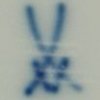Johann Friedrich Böttger is the one who brought porcelain to Europe. At his times porcelain was as valuable as gold. It took an alchemist to invent porcelain in Europe. Being just 18 year old Böttger was arrested and by order of Augustus the Strong brought to Dresden. He committed no crime but the elector of Saxony heard of his efforts to produce gold using alchemy. Augustus made Böttger to work for him but his efforts to manufacture gold were fruitless. In 1703 he tried to escape to Prague but was caught and brought back to Dresden.
And in this hopeless situation in the story appears Ehrenfried Walter von Tschirnhaus who worked for 20 years trying to discover secret of a true porcelain. In 1705 both scientists started to work in Meissen.
It took next three years, many efforts and moving again to laboratory in Dresden fortress to finally discover practical porcelain production recipe. It was 1708 and production in Dresden started in 1709. At the same time Augustus the Strong build a Royal Porcelain Factory in Meissen. Production started there in June 1710.
At first, the manufacture produced red ware known now as Böttger stoneware. In 1713 they began production of a quality white porcelain. Böttger died in 1719. By that time, the Meissen factory was producing wares that eclipsed even the finest Chinese porcelain.
After Böttger’s death, charge of the factory took Johann Gregor Höroldt. He stayed there for 50 years and dominated the painting workshop. Höroldt created a rich palette of enamel colours to be used in decoration. His works are known as chinoiseries as they included typical orient scenes. His paints are still used to decorate porcelain.
In Meissen worked such famous modellers as Johann Gottlieb Kirchner and Johann Joachim Kändler. Kirchner, was the first to make large-scale statues and figurines, especially of Baroque saints.Kirchner resigned in 1733 and then his assistant Kändler took over the position of a chief “modelmaster”. Kändler has become the most famous of Meissen modellers. His rococo style figurines influenced porcelain making in all of Europe. He worked for Meissen until he died in 1775.
The second half of 18th century marked the transition to neoclassical designs. Michel Victor Acier was appointed as master modeller. Mythological figures dominated Meissen production during his period.
Acier’s successor was Count Camillo Marcolini who managed company in the 1774 – 1815 period. Marcolini’s rule ended period ended with enormously high debts. Thanks to technical innovations and producing wares that were tailored to the tastes of the time, financial situation of the company improved. In 1830 it changed name to Staatliche Porzellan Manufaktur.
In 1861 – 1864 was build present production site in Meißen’s Triebisch Valley. In 1916 was inaugurated a Porcelain Museum in Meissen.
From 1991 the Enterprise is run as a public limited company operating under the name of Staatliche Meissener Porzellan-Manufaktur GmbH. It’s shareholder is the federal state of Saxony. Meissen factory still produces the most expensive porcelain in the world.
Here is the article on dating Meissen porcelain 1948 - 2015.

